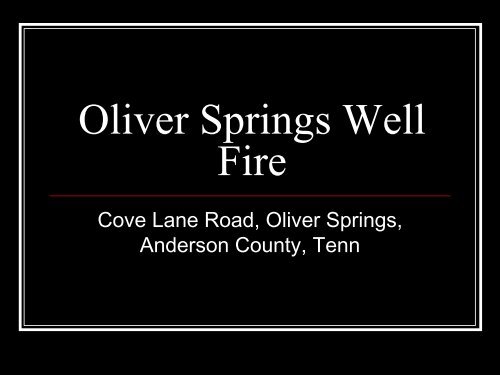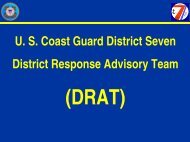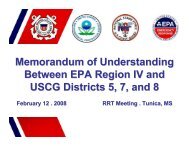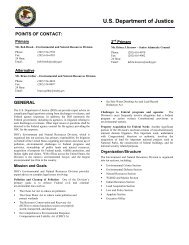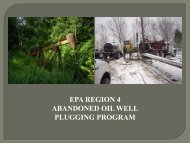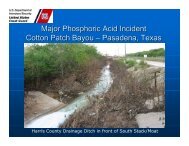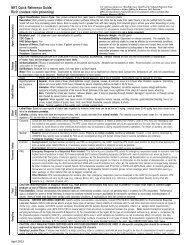Oliver Springs Well Fire - U.S. National Response Team (NRT)
Oliver Springs Well Fire - U.S. National Response Team (NRT)
Oliver Springs Well Fire - U.S. National Response Team (NRT)
Create successful ePaper yourself
Turn your PDF publications into a flip-book with our unique Google optimized e-Paper software.
<strong>Oliver</strong> <strong>Springs</strong> <strong>Well</strong><br />
<strong>Fire</strong><br />
Cove Lane Road, <strong>Oliver</strong> <strong>Springs</strong>,<br />
Anderson County, Tenn
<strong>Oliver</strong> <strong>Springs</strong> <strong>Well</strong> <strong>Fire</strong><br />
March 18, 2008<br />
• Initial release from the<br />
well<br />
• Location – <strong>Oliver</strong><br />
<strong>Springs</strong> is 10 miles<br />
west of Oak Ridge and<br />
22 miles west of<br />
Knoxville.
<strong>Oliver</strong> <strong>Springs</strong> <strong>Well</strong> <strong>Fire</strong><br />
• Light crude oil running<br />
down the hillside
<strong>Oliver</strong> <strong>Springs</strong> <strong>Well</strong> <strong>Fire</strong><br />
• Plume from the initial<br />
release moving<br />
towards the southeast
<strong>Oliver</strong> <strong>Springs</strong> <strong>Well</strong> <strong>Fire</strong><br />
March 19, 2008<br />
• <strong>Fire</strong> burning at<br />
wellhead location as<br />
well as downgradient<br />
locations
<strong>Oliver</strong> <strong>Springs</strong> <strong>Well</strong> <strong>Fire</strong><br />
• <strong>Fire</strong> burning on the<br />
surface of the<br />
Pennington Lake<br />
downgradient of<br />
wellhead location
<strong>Oliver</strong> <strong>Springs</strong> <strong>Well</strong> <strong>Fire</strong><br />
• <strong>Fire</strong> burning with the<br />
Pennington Lake in<br />
the foreground
<strong>Oliver</strong> <strong>Springs</strong> <strong>Well</strong> <strong>Fire</strong><br />
• Car that was engulfed<br />
in flames immediately<br />
downgradient of the<br />
wellhead location
<strong>Oliver</strong> <strong>Springs</strong> <strong>Well</strong> <strong>Fire</strong><br />
• Equipment that was<br />
engulfed in flames<br />
immediately<br />
downgradient of the<br />
wellhead location
<strong>Oliver</strong> <strong>Springs</strong> <strong>Well</strong> <strong>Fire</strong><br />
• Local responders<br />
staged south of the<br />
fire along Cove Lane.
<strong>Oliver</strong> <strong>Springs</strong> <strong>Well</strong> <strong>Fire</strong><br />
March 19, 2008<br />
• Local residents<br />
evacuating from the<br />
area while fire rages in<br />
background
<strong>Oliver</strong> <strong>Springs</strong> <strong>Well</strong> <strong>Fire</strong><br />
• 225 MB movie clip<br />
here….
<strong>Oliver</strong> <strong>Springs</strong> <strong>Well</strong> <strong>Fire</strong><br />
• Absorbent boom<br />
placed downstream of<br />
the primary retention<br />
pond in Wright Creek.
<strong>Oliver</strong> <strong>Springs</strong> <strong>Well</strong> <strong>Fire</strong><br />
• Siding on the<br />
Daugherty house<br />
warped from the<br />
intense heat from the<br />
fire.<br />
• 4 homes within 300<br />
yards of well site.
<strong>Oliver</strong> <strong>Springs</strong> <strong>Well</strong> <strong>Fire</strong><br />
March 19, 2008<br />
• Wild <strong>Well</strong>s Services<br />
from Houston, Texas<br />
responded to<br />
extinguish fire.<br />
• Majority of Wild <strong>Well</strong>s<br />
employees have 20+<br />
years of oil and gas<br />
fire fighting<br />
experience.
<strong>Oliver</strong> <strong>Springs</strong> <strong>Well</strong> <strong>Fire</strong><br />
March 20, 2008<br />
• Wild <strong>Well</strong>s mobed<br />
personnel and equipment<br />
to fight fire.<br />
• Cleared and benched<br />
hillside to allow for room to<br />
maneuver equipment into<br />
place.<br />
• Established drainage and<br />
retention pond system to<br />
collect fire fighting water<br />
and oil from hillside.
<strong>Oliver</strong> <strong>Springs</strong> <strong>Well</strong> <strong>Fire</strong><br />
March 21, 2008<br />
• Wild <strong>Well</strong> Control<br />
pumping water from<br />
Pennington Lake
<strong>Oliver</strong> <strong>Springs</strong> <strong>Well</strong> <strong>Fire</strong><br />
• Water cannons used<br />
to reduce radiant heat<br />
from the wellhead<br />
during debris removal<br />
operations
<strong>Oliver</strong> <strong>Springs</strong> <strong>Well</strong> <strong>Fire</strong><br />
March 21, 2008<br />
• Deploying hard boom<br />
and absorbent boom<br />
at additional<br />
downstream locations
<strong>Oliver</strong> <strong>Springs</strong> <strong>Well</strong> <strong>Fire</strong><br />
• March 20 th , START began<br />
perimeter air monitor using<br />
the EPA Rapid<br />
Assessment Tool (RAT).<br />
• Also conducted individual<br />
home assessments during<br />
response.<br />
• Results presented at daily<br />
public meetings.
<strong>Oliver</strong> <strong>Springs</strong> <strong>Well</strong> <strong>Fire</strong>- USCG<br />
Strike <strong>Team</strong><br />
• Strike <strong>Team</strong> deployed to<br />
assist with response –<br />
members from Gulf, Pacific<br />
and Atlantic<br />
• Monitored fire and air levels<br />
24/7<br />
• Directed Health and Safety<br />
efforts through out the<br />
response.<br />
• Assisted with Ops, individual<br />
home assessments, and<br />
daily public briefings.
<strong>Oliver</strong> <strong>Springs</strong> <strong>Well</strong> <strong>Fire</strong><br />
• EPA informing local<br />
news stations of the<br />
response efforts.<br />
• Public Meetings held<br />
daily to inform locals<br />
of smoke plume-air<br />
monitoring results and<br />
clean up progress.
<strong>Oliver</strong> <strong>Springs</strong> <strong>Well</strong> <strong>Fire</strong><br />
March 25, 2008<br />
• <strong>Fire</strong> was extinguished with<br />
water cannon water above and<br />
below venturi tube to displace<br />
oxygen.<br />
• A third attempt to gain control<br />
of well using heavy water<br />
failed.<br />
• Necessitated using<br />
conventional “stabbing<br />
method”. (1-2% chance of<br />
success)<br />
• The wellhead was capped the<br />
afternoon of March 25, 2008
<strong>Oliver</strong> <strong>Springs</strong> – RRT Conference<br />
Calls<br />
• March 26 th – Original Intent<br />
was to inform members that<br />
the well was re-ignited to gain<br />
control of run off. Since<br />
stabbing worked, call was<br />
used to update RRT members<br />
and proceed with Federal<br />
Assumption.<br />
• March 28 th – inform members<br />
of placing well into production<br />
to reduce pressure of well<br />
head. Advice given by experts<br />
in industry as well as EPA Reg<br />
6.
<strong>Oliver</strong> <strong>Springs</strong> <strong>Well</strong> <strong>Fire</strong><br />
• Removal of the failed<br />
blowout preventer.
Post <strong>Fire</strong> – Removal Phase<br />
• Federal Assumption<br />
Weds, March 26 th .<br />
• Storage, Treatment,<br />
and Disposal of<br />
300,000 gallons of<br />
retention pond water<br />
and oil.<br />
• Disposal of 4000 cubic<br />
yds of contaminated<br />
soil.
Post <strong>Fire</strong> – Removal Phase<br />
• Establish a oilgroundwater<br />
recovery<br />
system in floodplain<br />
below well site.<br />
• Site restoration,<br />
reseeding, some<br />
residential sampling.
<strong>Oliver</strong> <strong>Springs</strong> - Funding from NPFC<br />
• Case Officer – Miguel<br />
Bella, USCG<br />
• EPA provided updates on<br />
a daily basis including RP<br />
information and insurers.<br />
• Conducted site visit on<br />
April 2 nd .<br />
• Has provided EPA with 1.8<br />
million to conduct<br />
necessary clean up and<br />
oversight activities.
<strong>Oliver</strong> <strong>Springs</strong> – TDEC Fines<br />
• TN Oil & Gas “red<br />
tagged” the capped<br />
wellhead assembly.<br />
• Walden Resources<br />
fined $50,000 for<br />
drilling beyond<br />
permitted depth of<br />
3000 ft (drilled to 3900<br />
ft).
<strong>Oliver</strong> <strong>Springs</strong> <strong>Well</strong> <strong>Fire</strong><br />
• Real-time air<br />
monitoring at the well<br />
head using AreaRAEs.<br />
• Remote display and<br />
data logging setup a<br />
command post.
Post <strong>Fire</strong> – Restoration Phase<br />
• Restored slopes along<br />
the Pennington pond.
<strong>Oliver</strong> <strong>Springs</strong> <strong>Well</strong> <strong>Fire</strong><br />
• Location of oil seep at<br />
the base of the hillside<br />
inline with the<br />
wellhead.
<strong>Oliver</strong> <strong>Springs</strong> <strong>Well</strong> <strong>Fire</strong><br />
• Oil seen seeping into<br />
a interceptor trench at<br />
the base of the hill<br />
below the wellhead.<br />
• The oil seems to be<br />
traveling along the<br />
bedrock.
<strong>Oliver</strong> <strong>Springs</strong> – restored hillside and<br />
well site
<strong>Oliver</strong> <strong>Springs</strong> - <strong>Well</strong> placed into<br />
Production<br />
• Dec 1 st 2008 -<br />
Through an<br />
Administrative Order<br />
Walden Resources<br />
began producing oil<br />
and gas.
<strong>Oliver</strong> <strong>Springs</strong> – Production Numbers<br />
• Natural Gas- 0.5<br />
million cubic feet per<br />
day<br />
• Approx 300 barrels of<br />
light crude oil per day
“Big Picture” – Future Considerations<br />
• 400 new wells to be<br />
drilled in east Tenn<br />
during 2008-2009.<br />
• Ranging from large<br />
companies such as<br />
Atlas and Chesapeake<br />
Natural Gas to small<br />
independent drillers
Lessons Learned – TDEC Revised Oil<br />
and Gas Measures<br />
• 2 day certification<br />
training for all drillers<br />
and well operators.<br />
• Emphasis on proper<br />
notification process to<br />
TEMA, TDEC, NRC<br />
• “Double stacked” Blow<br />
Out Preventers<br />
(BOP’s)
Opportunities for EPA exercises with<br />
State and local responders<br />
• Opportunity to<br />
exercise with TEMA,<br />
TDEC and local EMA<br />
coordinators on<br />
lessons learned plus<br />
oil spill recovery<br />
techniques and proper<br />
notification methods.
Key Contacts<br />
• TDEC – Jeff Laxton, Oil and Gas Division<br />
cell (865) 207-0733<br />
• EPA – Perry Gaughan, OSC<br />
cell (404) 909-2930<br />
• Oil and Gas Consultant – Mick Reed<br />
Greystar Engineering cell (606) 791-1306
Kudos<br />
• to EPA’s Chuck Eger, Rick Jardine, Carter<br />
Williamson, Sheryl Carbonaro, Paula White<br />
and Wilda Cobb<br />
• to USCG Strike <strong>Team</strong><br />
• to Tetra Tech Start <strong>Team</strong>
THE END


